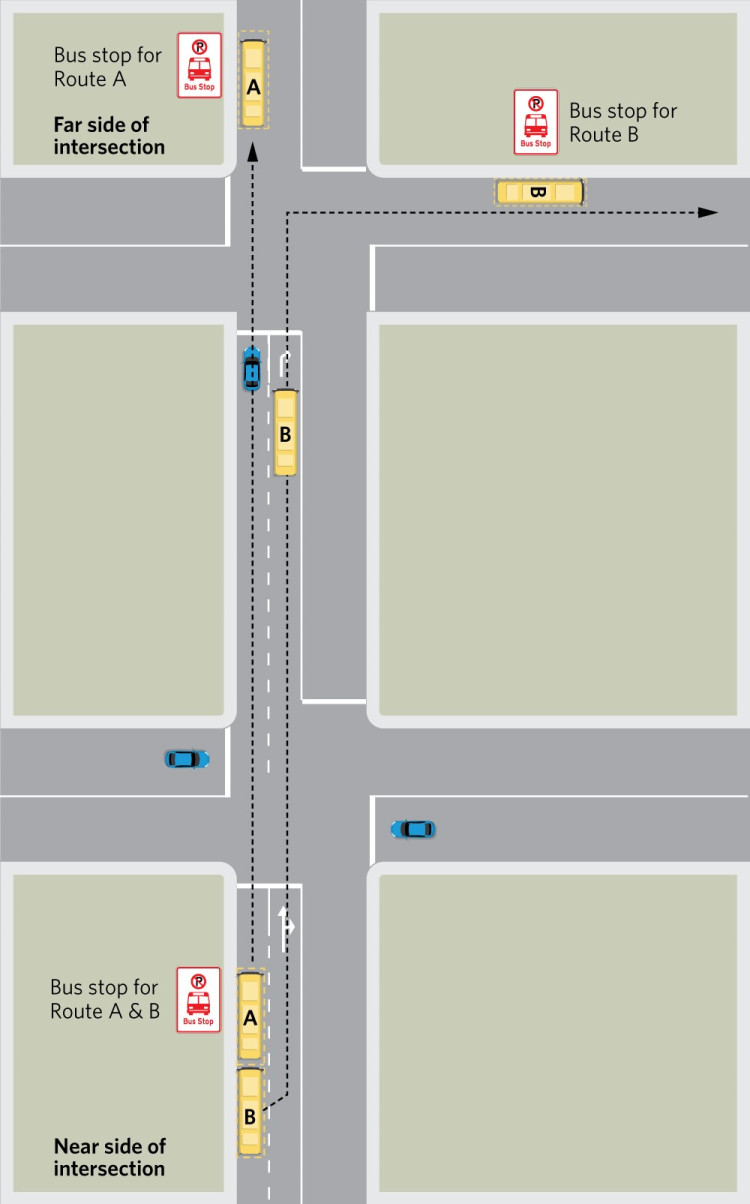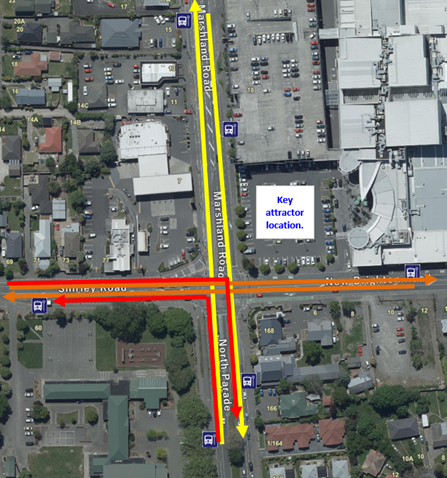Locating bus stops near intersections maximises walking catchments, however, there are a number of matters to consider in selecting whether to locate the stop before or after the intersection, or in-between intersections, with potential impacts on safety, bus capacity and signal operations.
The three broad choices for locating bus stops near intersections are to locate them:
Locating bus stops in the direct vicinity of intersections maximises walking catchments by increasing the number of directions with a direct path to stops, so are often preferred over mid-block locations. However, take care when locating bus stops within the direct proximity of intersections, as stop design has impacts on safety, bus capacity and signal operations.
It is generally recommended to avoid locating bus stops within about 12m of pedestrian crossings and 20–60m of an intersection due to the potential for blocking sight lines. The figure below illustrates bus stop placement around intersections.

Bus stop crossroad placement.
Driveways or other infrastructure may affect the possible proximity of bus stop location relative to an intersection. Some intersections are commercial nodes and town centre locations, so availability of kerb space and catchment could be a deciding factor on bus stop location.
The optimal location of bus stops at intersections vary based on local context, so assess location on a case-by-case basis. When locating bus stops near intersections there are four main considerations.
Advantages, disadvantages, and practice guidance in terms of stop location choice is in the table below.
Table: Advantages, disadvantages, and practice guidance for stop location choice
|
Location |
Advantages |
Disadvantages |
Practice guidance |
|
Near-side of intersection |
Can be paired with priority measures Takes advantage of red phase at signalised intersections May be necessary if a common stop is required before the intersection before routes diverge |
May conflict with left-turning vehicles May be difficult for buses turning right at the intersection to merge into the right-turning lane Affects sight lines from side roads at priority-controlled intersections |
Ensure safe sight lines for pedestrian crossings Ensure sight lines for vehicles on side roads are met (applies at priority-controlled intersections only) |
|
Far-side of intersection |
Eliminates conflicts with left-turning vehicles Allows the bus to clear the intersection, blocking fewer movements and sight lines |
Could result in traffic queued into the intersection if a bus stops in the travel lane or multiple buses arrive at once May cause difficulty for a bus that must turn right at an intersection on a multi-lane road to reach the right-hand lane from a kerbside stop just before the intersection |
Don’t block traffic exiting the intersection Allow time for a vehicle directly behind the bus to react safely to the bus stopping |
|
Mid-block away from intersection |
Eliminates conflicts with intersections |
Reduces walking catchments and access to crossings |
Locate a crossing point within 50m of the bus stop (ideally) Locate bus stops on the departure side of mid-block zebra crossings |
The choice of bus stop location should also consider key trip origin and destination points and minimise pedestrian walking distances, where feasible. Locate bus stops to encourage connections between buses, trains and ferries. Stops should be close to where different bus routes or other passenger transport services intersect to minimise walking time for connecting passengers (see the figure below).

Bus stops located near an attractor location to encourage connections, The Palms, Christchurch. (Source: Environment Canterbury)
If bus priority signals are provided at an intersection, their operation should be designed in conjunction with bus stop placement and bus lanes.
Bus lanes at intersections are recommended where bus priority signals are to be implemented.
For more information about best practice priority signals see:
PTDG: Public transport priority and optimisation
In general, bus stop placement near intersections is preferred because it increases the walking catchment of the bus stop. Bus stops may be placed mid-block if the available road width does not allow safe and efficient location close to an intersection, provided the block length does not adversely affect the walking catchment.
Safe crossing facilities are an important consideration with mid-block stops.